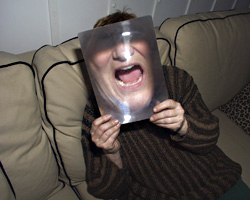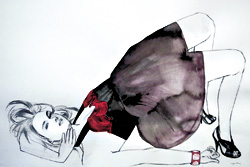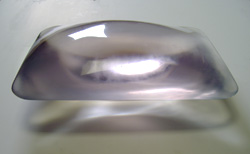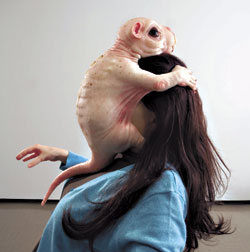From coffee shops to boutique salons, it seems the trendy thing to do is put holes in the wall and make like an art gallery. But despite the best intentions, the art in most of these nongallery venues simply disappears behind all the double-skim lattes and volumizing shampoos.
Happily, there is an exception to this rule. Since opening OKOK, a Ballard book/toy store, last June, Amanda and Charlie Kitchings have put on a series of strong shows in which the art isn’t dulled down by its proximity to merchandise. On the contrary, the interaction of the two is part of the experience, especially at this month’s show, “The Stable.”
For this exhibit, the Kitchings handed the gallery half of their space over to co-curators Jason Fulford and Leanne Shapton. They’re key figures at East Coast publishing house J&L Books, which has been producing books of previously unpublished or rarely seen work by contemporary artists for seven years. All of the artists on display in “The Stable” are part of the publisher’s roster.
The exhibit consists of a dense array of more than 40 sketches and snapshotlike photographs, plus a table full of J&L books and two wall-mounted shelves of wooden books—carved replicas of David Sedaris’ Me Talk Pretty One Day, Henry Miller’s Tropic of Cancer, and others. The art is compelling, the books—both real and wooden—equally so.
While Baltimore-based Michael Northrup’s photographs are titled after the numbers his digital camera assigns to them, they are full of humanity. In P3170011 (Mouth), a man slumps on a lifeless, beige couch holding a plastic magnifying sheet in front of his open mouth. The portrait is both achingly funny and painfully sad. The dark room reads as tired, the open mouth not laughing but rather serious. Nevertheless, the character of the sitter is funny. He is, after all, performing for the camera.
One of the largest images in the show, DSCF1811 (Reflectors), acts like a beacon on the opposing wall. Two bright-orange traffic barrels reflect off a wintry, gray scene. Here, too, the playfulness of the glowing image is tempered by the cold and lonely, deserted street.
Digging through the pile of J&L books on the table in the middle of the gallery, it becomes clear that this balancing of ambiguity is a thread throughout Northrup’s work. His book, Beautiful Ecstasy, features deeply honest images of small-town America in the ’70s and ’80s, with opposing emotions present in a single image. In these photographs of young families going about their daily lives, delight and humor appear in tandem with tragedy and danger.
Perfectly in concert with Northrup’s work are several of Harrell Fletcher’s small-scale photographs. Though Portland-based Fletcher is something of a local art legend (he’s one of the few Northwest artists to have appeared in the Whitney Biennial and has gallery representation in all the major art hubs), his work is also always wonderfully inconspicuous. In Downstairs Bathroom, brown and yellow wallpaper precisely captures 1970s America; in Jackie, a young child struggles up some stairs.
The works on the wall are tame, however, compared to those in a recent J&L book of Fletcher images that’s also on display. These are photos Fletcher took when visiting Vietnam’s War Remnants Museum, which documents alleged human-rights violations and atrocities committed by U.S. and French forces. Fletcher was so moved by the exhibit, he photographed the show, capturing both the images and their accompanying text descriptions. J&L then reprinted Fletcher’s photographs in a book so tiny you have to get “friendly” with it in order to see the images. Holding these gruesome pictures of war so close repositions your role as the objective viewer, making it difficult to maintain a voyeuristic distance.
And this is precisely what Fulford and Shapton, J&L Books, and the Kitchings all do best. They create balanced environments—whether inside the pages of a book or on the white walls of a gallery—in which the art experience is so approachable, and therefore fundamentally wrapped up in the human experience, it is hard, if not impossible, to miss.








